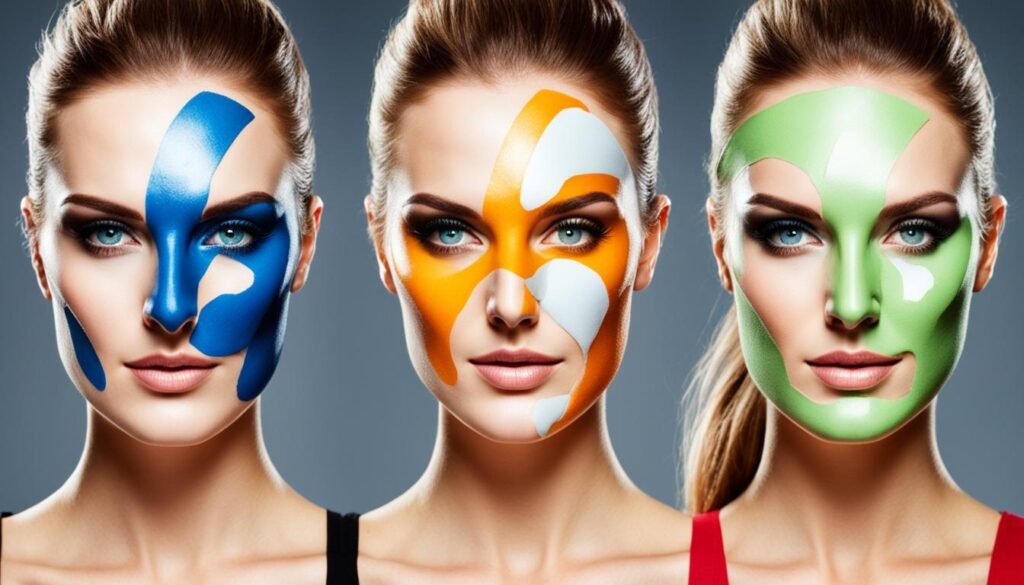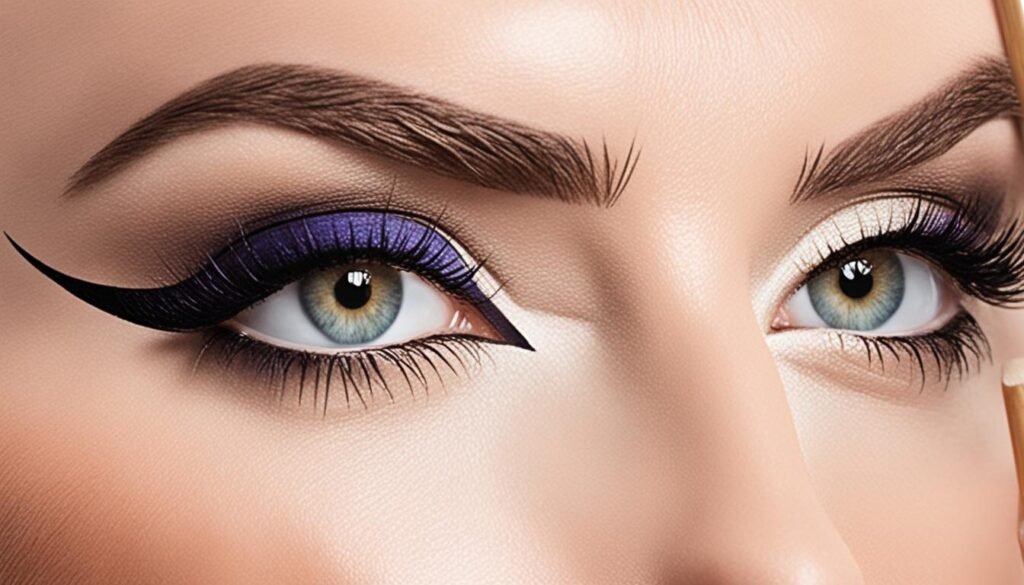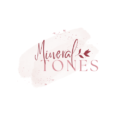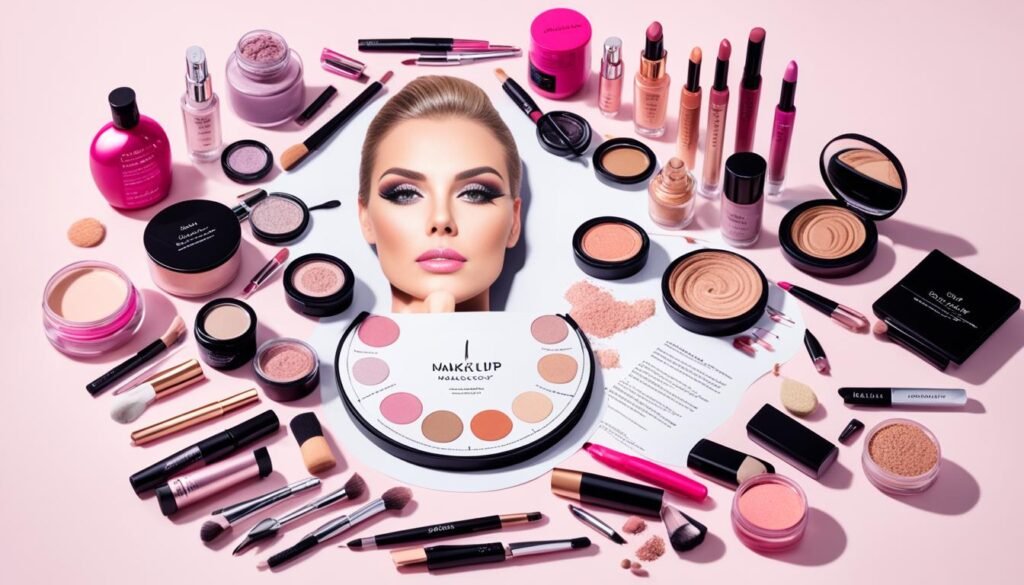Are you often left baffled by the jargon and terminology used in the world of makeup? From contouring and baking to tight lining and strobing, the beauty industry has its own lexicon that can feel overwhelming to navigate. However, understanding these terms is essential if you want to confidently explore the world of cosmetics and expand your beauty vocabulary. In this makeup dictionary, we will unravel the mysteries of makeup terminology, empowering you to speak the language of beauty with confidence.
Key Takeaways:
- Understanding makeup terminology is crucial to navigate the world of cosmetics.
- Contouring and highlighting techniques can enhance facial features.
- Baking and buffing techniques help achieve a flawless finish.
- Multimasking and spotlighting techniques cater to specific skin concerns.
- Floating eyeliner and reverse cat eye create unique and dramatic eye looks.
Contouring and Highlighting
Contouring and highlighting are two makeup techniques that can completely transform your face. They allow you to sculpt and enhance your features, bringing out your natural beauty. Let’s take a closer look at these techniques and how they can elevate your makeup game.
Contouring
Contouring involves using products like bronzer or foundation to create shadows and depth on the face. By strategically applying a shade that is a few tones darker than your skin tone, you can sculpt your face and create the illusion of higher cheekbones, a slimmer nose, and a more defined jawline. The key to successful contouring is blending, ensuring a seamless transition between the contour shade and your natural skin tone.
For precise contouring, start by applying the contour product to the hollows of your cheeks, blending it upwards towards your temples. You can also apply it along the hairline, underneath the jawline, and on the sides of your nose if desired. Remember to use a light hand and build up the intensity gradually to achieve a natural and sculpted look.
Highlighting
Highlighting is the opposite of contouring and involves adding brightness and radiance to specific areas of the face. By applying a lighter product to high points such as the cheekbones, brow bone, bridge of the nose, and cupid’s bow, you can achieve a youthful and glowing complexion. The key to successful highlighting is to use a shade that complements your skin tone and has a subtle shimmer or sheen.
When applying highlighter, use a fan brush or a small fluffy brush and sweep the product onto the targeted areas. Blend it gently to avoid harsh lines and create a seamless glow. Remember, a little goes a long way, so start with a small amount and build up if necessary.
Additionally, the term “contour” can also refer to the area of the eye where the eyelid creases. This can be accentuated using eyeshadow to create depth and dimension, making the eyes appear more defined and captivating.
| Contouring | Highlighting |
|---|---|
| Creates shadows and depth | Adds brightness and radiance |
| Uses bronzer or foundation a few shades darker than skin tone | Uses a lighter product |
| Emphasizes features and creates sculpted look | Enhances high points for a radiant complexion |
| Blends for a seamless transition with natural skin tone | Use a shade that complements skin tone |
Contouring and highlighting go hand in hand, allowing you to create balance and dimension in your makeup look. Whether you prefer a subtle everyday contour and highlight or a more dramatic effect for special occasions, these techniques are versatile and can be customized to suit your preferences. Experiment with different shades and formulas to find what works best for you, and remember to have fun with it!
Baking and Buffing
In the world of makeup, various techniques can help you achieve a flawless and airbrushed look. Two popular methods are baking and buffing. Let’s take a closer look at these techniques and how they can enhance your makeup application.
Baking
Baking is a technique that involves applying a generous amount of translucent powder to the face and allowing it to sit for a few minutes before dusting it off. This method is commonly used to set foundation and concealer, ensuring a long-lasting and crease-free finish.
To bake your makeup, follow these steps:
- Apply your regular foundation and concealer.
- Using a damp beauty blender or makeup sponge, pick up a generous amount of translucent powder.
- Press the powder onto the areas where you applied your concealer, such as under the eyes, along the T-zone, and on the chin.
- Leave the powder on your face for a few minutes to allow it to “bake” and set the makeup.
- Gently dust off the excess powder using a fluffy brush.
This technique not only helps to set your makeup but also provides a smooth and flawless base. By baking, you can achieve a crease-free and long-lasting look, perfect for special occasions or all-day wear.
Buffing
Buffing is a technique that involves using a damp beauty blender or makeup sponge to blend foundation into the skin in circular motions. This method helps to achieve a seamless and airbrushed finish, providing a natural-looking complexion with a soft-focus effect.
Here’s how to buff your foundation for a flawless look:
- Apply your foundation to the skin using a brush or your fingertips.
- Dampen a beauty blender or makeup sponge with water and squeeze out any excess moisture.
- Using the rounded end of the sponge, bounce and roll the sponge across your face, blending the foundation into your skin in circular motions.
- Continue buffing until the foundation is evenly blended and there are no visible lines or streaks.
- For areas that require more coverage, such as blemishes or redness, gently press the sponge onto the area to build up the foundation.
Buffing allows you to achieve a natural and airbrushed look by seamlessly blending your foundation into the skin. The circular motions help to diffuse the product, providing a soft and flawless appearance.
Now that you’re familiar with baking and buffing techniques, you can experiment with these methods to enhance your makeup application and achieve a flawless and airbrushed finish.
Multimasking and Spotlighting
In the world of skincare, there are various techniques and products that can help address different skin problems. Multimasking is one such technique that has gained popularity in recent years. It involves using multiple face masks on different areas of the face to target specific skin concerns, resulting in a customized skincare routine.
Each area of the face may have different needs, such as oily T-zone, dry cheeks, or acne-prone chin. With multimasking, you can use masks specifically formulated to treat these areas, giving your skin the attention and care it deserves. For example, you can apply a clay mask on the T-zone to control excess oil, a hydrating mask on the cheeks to moisturize, and an acne-fighting mask on the chin.
By addressing each area’s unique needs, multimasking allows you to create a tailored skincare routine that effectively treats different skin problems simultaneously. It’s like giving your skin a personalized spa treatment right at home.
How to Multimask:
- Cleanse your face to remove any dirt or makeup residue.
- Identify the different skin concerns you want to target.
- Select masks suitable for each specific concern.
- Apply each mask to the corresponding area of your face.
- Leave the masks on for the recommended duration.
- Rinse off the masks using lukewarm water.
- Follow up with your regular skincare routine, such as toner and moisturizer.
Another popular technique in the world of skincare is spotlighting. Unlike traditional highlighting with shimmers and powders, spotlighting involves using a highlighting balm or crème to create a natural glow on the skin.
The spotlighting technique focuses on enhancing your skin’s natural radiance and brightness, giving you a subtle yet luminous glow. It’s perfect for those who prefer a more understated and dewy look.
“Spotlighting allows you to achieve a lit-from-within glow without the use of traditional shimmers and powders,” says Emma Watson, a skincare expert at Mineral Tones.
To spotlight, simply apply a small amount of highlighting balm or crème on the high points of your face, such as the cheekbones, brow bone, and bridge of the nose. Gently blend it into the skin using your fingertips or a makeup sponge for a seamless and natural finish.
Spotlighting gives you control over the intensity of the glow, allowing you to create a subtle daytime look or amp it up for special occasions. It’s a versatile technique that complements various makeup styles and skin tones.
If you’re looking to achieve healthy-looking skin with targeted treatments and a natural glow, give multimasking and spotlighting a try. These techniques offer a fresh approach to skincare and makeup, helping you address different skin problems while enhancing your natural beauty.

Floating Eyeliner and Reverse Cat Eye
If you’re looking to amp up your eye makeup game and create a bold and edgy look, floating eyeliner and the reverse cat eye are two techniques worth trying. These eye-catching styles will add a touch of drama and take your makeup to the next level.
Floating eyeliner is all about breaking the rules and experimenting with unconventional placements. Instead of applying your eyeliner along the lash line, try placing it higher up on the lids or even above the eye crease. This technique creates a unique and edgy look that instantly grabs attention. Whether you opt for a sleek and precise line or a smudged and smoky effect, floating eyeliner allows for endless creativity.
On the other hand, the reverse cat eye puts a contemporary twist on the classic winged eyeliner. Instead of extending the wing outward from the outer corners of the eyes, the reverse cat eye involves drawing the wing from the inner corners, extending it towards the temples. This reversed placement creates a bold and dramatic effect, accentuating the eyes in a unique way.
Why Choose Floating Eyeliner and Reverse Cat Eye?
- Create an edgy and unconventional look
- Add drama and boldness to your makeup
- Experiment with different eyeliner placements
- Enhance your eye shape with unique techniques
Whether you’re attending a special event or simply want to express your creativity, floating eyeliner and the reverse cat eye are fantastic options for achieving a distinct and memorable makeup look. Don’t be afraid to step outside the box and try these daring techniques!
Tight Lining and Lit
Tight lining is a makeup technique that involves applying eyeliner along the waterline or upper or lower lid to create the illusion of bigger and naturally defined eyes. Whether you prefer a subtle or bold look, tight lining is a versatile method that can enhance your eye shape and make your lashes appear fuller.
To achieve the tight lining effect, opt for a creamy eyeliner like the Kohl Pencil from Mineral Tones. Its smooth texture glides on effortlessly, allowing precise application along the lash line. The rich pigment of the kohl pencil intensifies the color and adds depth to your eyes, making them stand out.
For a lit-from-within glow, having your highlighter on point is a must. Whether you prefer a blinding or subtle glow, a highlighter can give your skin a radiant and luminous appearance. It’s the perfect finishing touch to any makeup look, adding a touch of light to the high points of your face for a youthful and fresh complexion.
When it comes to achieving a lit look, the Highlighter Palette from Mineral Sparkle is a game-changer. This palette features a range of shades to suit different skin tones and preferences. With its blendable and buildable formula, it allows you to achieve a natural glow or a blinding highlight that catches the light in all the right ways.
“Tight lining and a lit highlighter can instantly elevate your makeup game. They enhance your features and give you a fresh and glowing appearance.” – Beauty Expert, Mineral Tones
Why choose tight lining and a lit highlighter?
- Tight lining makes your eyes appear bigger and creates a more defined look.
- A lit highlighter adds a radiant glow and enhances your natural features.
- These techniques complement a variety of makeup styles, from natural to glam.
- You can easily customize the intensity of both techniques to suit your preferences.
Whether you’re aiming for a natural everyday look or going for a bold and dramatic style, tight lining and a lit highlighter can take your makeup game to the next level. Embrace the power of defined eyes and a radiant glow, and watch as your features light up with confidence.
Beat Face and Cut Crease
In the world of makeup, achieving a flawless and impeccable look is often referred to as a beat face. It’s the epitome of flawless makeup application that looks stunning from every angle. Whether you’re attending a special event or just want to feel your best, a beat face is the ultimate goal.
Creating a beat face involves skillful techniques, precise application, and high-quality products. It’s all about achieving a flawless complexion, perfectly defined features, and a radiant glow that makes heads turn. From a flawless base to expertly sculpted cheekbones, each element of a beat face is carefully executed to achieve a stunning overall look.
One of the key elements in achieving a beat face is the eye makeup, and a popular technique that adds drama and definition to the eyes is the cut crease. The eye crease refers to the natural crease on the eyelid, and the cut crease technique involves using eyeshadow to define and enhance this crease, creating a sharp and prominent look.

Using a contrasting eyeshadow color, typically darker than the lid color, the cut crease technique creates a distinct separation between the lid and the crease. This technique adds depth and dimension to the eyes, making them appear larger and more defined. It’s a popular choice for creating captivating and dramatic eye looks that instantly grab attention.
Whether you’re a makeup enthusiast or a professional artist, mastering the art of a beat face and the cut crease technique is essential in creating stunning makeup looks. With the right technique, products, and a touch of creativity, you can achieve a flawless and captivating appearance that makes a lasting impression.
Garage Doors and Strobing
Looking to add some excitement to your eye makeup? Try the super trendy “garage doors” technique that gained popularity in the 80s and is now making a comeback. This eyeshadow technique involves wearing a single shade from the lids all the way up to the brows, creating a bold and vibrant look that’s sure to turn heads. The seamless color transition gives the illusion of a door opening, hence the name “garage doors.”
Take your eye makeup to the next level with strobing, a highlighting technique that’s all about creating a dewy and shimmery glow on your skin. Strobing focuses solely on highlighting, without the need for traditional contouring. By strategically applying a radiant highlighter to the high points of your face, such as the cheekbones, brow bones, and cupid’s bow, you can achieve a luminous complexion that catches the light in all the right places.
Get the Look: Floating Eyeshadow
Want to try something different with your eyeshadow? Experiment with the floating eyeshadow technique. This unique approach involves applying eyeshadow above the crease, creating an ethereal and eye-catching effect. By leaving a gap between the eyeshadow and your lash line, the floating eyeshadow technique creates the illusion of larger eyes and allows for endless creative possibilities. Let your imagination run wild and create stunning eye looks with this innovative technique.
Illuminator and Suede, Shimmer, Matte, Glitter
When it comes to achieving a radiant and glowing complexion, an illuminator is a must-have in your makeup arsenal. Similar to a highlighter, an illuminator adds a subtle glow or shimmer to the skin, enhancing its natural radiance and luminosity. Whether you prefer a soft and dewy finish or a more intense sheen, an illuminator can help you achieve that desired luminous look.
But what about eyeshadow finishes? When browsing through eyeshadow palettes, you may come across terms like suede, shimmer, matte, and glitter. These finishes describe the level of shimmer or glitter present in the eyeshadow, allowing you to create different effects and finishes. Suede finishes offer a soft, velvety texture, while shimmer finishes provide a luminous and light-reflecting effect. Matte finishes, on the other hand, have a flat and non-reflective appearance, perfect for creating a classic and understated look. And if you’re looking to add some drama and sparkle to your eye makeup, glitter finishes are the way to go, adding a touch of glamour and glitz.
So, whether you want to achieve a natural everyday glow or experiment with different eyeshadow finishes for a bold and statement-making look, the choices are endless. Visit Mineral Tones (www.mineraltones.com) and Mineral Sparkle (www.mineralsparkle.com) to explore a wide selection of illuminators and eyeshadows with various shimmer, suede, matte, and glitter finishes, allowing you to unleash your creativity and embrace your unique style.

